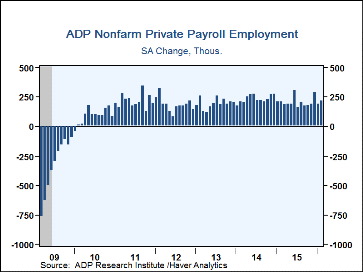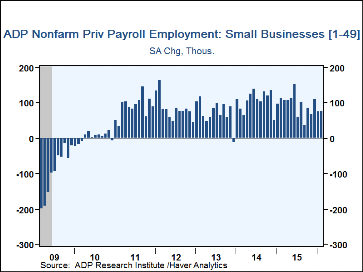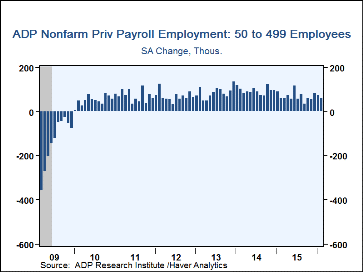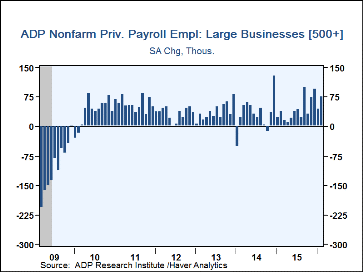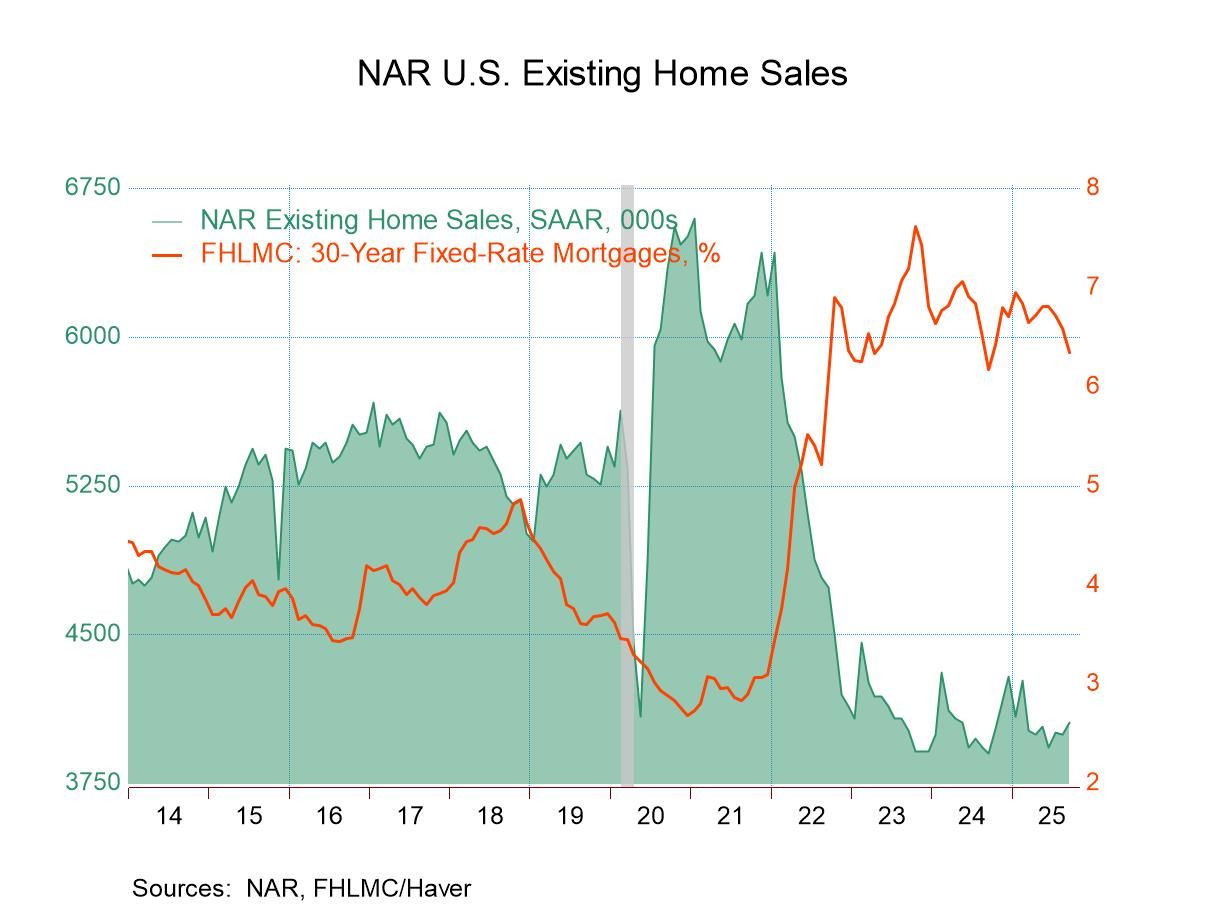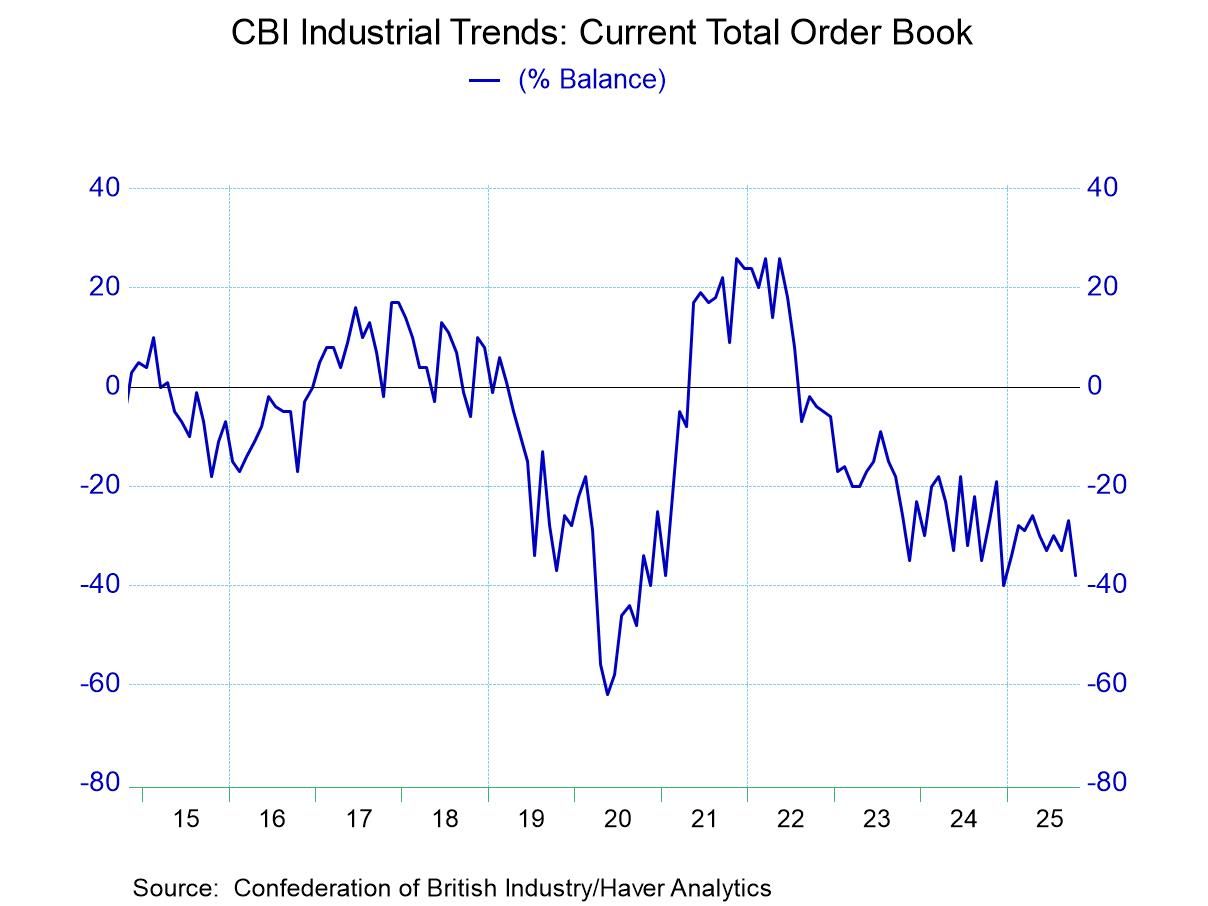 Global| Mar 02 2016
Global| Mar 02 2016U.S. ADP Reports Hiring Growth Improves
by:Tom Moeller
|in:Economy in Brief
Summary
The ADP/Moody's National Employment Report indicated that nonfarm private sector payrolls rose 214,000 during February versus 193,000 in January, revised from 205,000. The latest gain was firmer than expectations for a 195,000 rise in [...]
The ADP/Moody's National Employment Report indicated that nonfarm private sector payrolls rose 214,000 during February versus 193,000 in January, revised from 205,000. The latest gain was firmer than expectations for a 195,000 rise in the Action Economics Forecast Survey. During the last ten years, there has been a 97% correlation between the change in the ADP figure and the change in nonfarm private sector payrolls as measured by the Bureau of Labor Statistics. The latest report reflects annual benchmark revisions which were modest.
The ADP Research Institute survey is based on ADP's business payroll transaction system covering 411,000 companies and nearly 24 million employees. The data are processed by Moody's Analytics Inc., then calibrated and aligned with the BLS establishment survey data. The ADP data cover private sector employment, not government.
Small businesses led last month's job growth with a 76,000 rise (2.2% y/y) following a 75,000 increase. Large business payrolls also improved 76,000 (2.2% y/y) after a 44,000 gain. Amongst medium-sized employers, payrolls rose 62,000 (1.9% y/y), the weakest rise since November.
Service industry hiring increased 208,000 (2.4% y/y), about the same monthly rate as during the last year. Payrolls in professional & business services increased 59,000 (3.0% y/y) while employment in trade, transportation & utilities industries improved 21,000 (1.7% y/y), though growth recently has softened. The number of financial activities jobs rose a modest 8,000 (1.9% y/y), the weakest increase since July.
The pace of hiring in the goods-producing sector of the economy slackened to 5,000 (0.6% y/y) after two months of much stronger gain. Construction sector employment increased a firm 27,000 (3.7% y/y) while factory sector jobs declined 9,000 (0.1% y/y), the first fall since October.
The ADP National Employment Report data are maintained in Haver's USECON database; historical figures date back to April 2001 for the total and industry breakdown and back to January 2005 for the business size breakout. The expectation figure is available in Haver's AS1REPNA database.
| ADP/Moody's National Employment Report | Feb | Jan | Dec | Feb Y/Y | 2015 | 2014 | 2013 |
|---|---|---|---|---|---|---|---|
| Nonfarm Private Payroll Employment (m/m chg, 000s) | 214 | 193 | 287 | 2.1% | 2.3% | 2.2% | 1.9% |
| Small Payroll (1-49) | 76 | 75 | 109 | 2.2 | 2.6 | 2.1 | 1.9 |
| Medium Payroll (50-499) | 62 | 74 | 83 | 1.9 | 2.3 | 2.8 | 2.2 |
| Large Payroll (>500) | 76 | 44 | 95 | 2.2 | 1.7 | 1.6 | 1.5 |
| Goods-Producing | 5 | 19 | 38 | 0.6 | 1.8 | 2.4 | 1.8 |
| Construction | 27 | 26 | 32 | 3.7 | 4.5 | 4.7 | 3.7 |
| Manufacturing | -9 | 3 | 12 | 0.1 | 1.1 | 1.3 | 0.8 |
| Service-Producing | 208 | 174 | 249 | 2.4 | 2.4 | 2.2 | 1.9 |
Tom Moeller
AuthorMore in Author Profile »Prior to joining Haver Analytics in 2000, Mr. Moeller worked as the Economist at Chancellor Capital Management from 1985 to 1999. There, he developed comprehensive economic forecasts and interpreted economic data for equity and fixed income portfolio managers. Also at Chancellor, Mr. Moeller worked as an equity analyst and was responsible for researching and rating companies in the economically sensitive automobile and housing industries for investment in Chancellor’s equity portfolio. Prior to joining Chancellor, Mr. Moeller was an Economist at Citibank from 1979 to 1984. He also analyzed pricing behavior in the metals industry for the Council on Wage and Price Stability in Washington, D.C. In 1999, Mr. Moeller received the award for most accurate forecast from the Forecasters' Club of New York. From 1990 to 1992 he was President of the New York Association for Business Economists. Mr. Moeller earned an M.B.A. in Finance from Fordham University, where he graduated in 1987. He holds a Bachelor of Arts in Economics from George Washington University.


